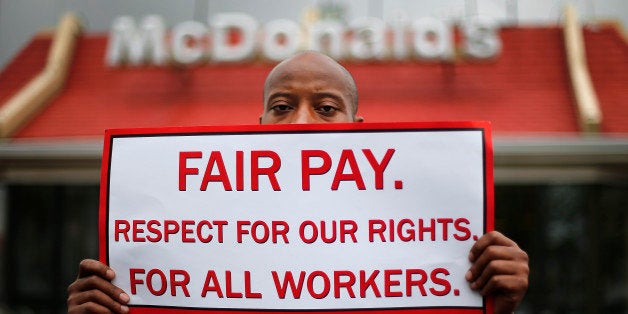
Fast-food workers are the public face of our part-time, low-wage economy. But when they protest on Thursday for higher wages and better conditions, they'll be joined by another group of workers who toil in obscurity.
Thousands of home-care workers -- people who take care of the elderly or disabled -- will join fast-food workers in nationwide protests on Thursday, according to organizers. These joint protests are "labor history in the making," according to Ileen DeVault, a professor of labor history at Cornell University. They signal that the spread of low-wage work at the expense of middle-class jobs is affecting workers across industries that might otherwise appear to have little in common.
Both fast-food workers and home-care workers tend to be low-paid, have unreliable schedules and lack access to benefits like paid leave and vacation.
These low-wage industries are among the fastest-growing job sectors in our economy. The number of home health aide jobs is expected to grow by 48 percent in the next 10 years, according to the Bureau of Labor Statistics. Fast food is expected to be the fifth-fastest-growing occupation during the same period, according to Demos, a think tank focused on low-wage workers.
"Home health care workers are facing the same kinds of challenges as fast-food workers and as workers at Walmart," said Robert Hiltonsmith, a senior policy analyst at Demos. "Unless we have a radical change in our country's jobs policy, for better or worse, these are the jobs of the near future."
The 2 million home-care workers in the U.S. are "especially challenged" compared to other low-wage workers, Hiltonsmith said. The workforce in that sector is about 90 percent female and consists disproportionately of immigrants, according to a 2013 report from the Economic Policy Institute, a think tank focused on labor issues. Fields that employ mostly women typically pay less. And immigrant workers may be hesitant to push for better wages and conditions, because their immigration status is often tied to employment.
This chart from EPI compares the median wages of home-care workers to workers in other industries.
Home-care workers also typically work alone, making it harder for them to organize. Labor activists have organized some home-care workers who are paid through government agencies like Medicaid. But those efforts recently suffered a setback when the Supreme Court ruled that Illinois home-care workers paid by the state couldn't be forced to pay union dues.
A recent visit from a union representative pushed Liliana Cordero, a home-care aide in Lansing, Illinois, to join fast-food workers in protesting for higher wages this week. Cordero, 37, supports her husband and three kids by working 52 hours a week for just $9.85 an hour, or about $26,600 a year. Even with help from food stamps, Cordero still needs payday loans to help make ends meet.
The fact that home-care workers are often employed by individuals or families, rather than by massive corporations like McDonald's, can make it hard to build sympathy for their plight.
"In many cases, people may be reluctant to have a negative feeling towards someone who is employing someone in their home," said Valerie Wilson, an economist at EPI. "It's more difficult to view those individuals as villains than it is to sort of vilify those large corporations."
Still, with baby boomers getting older, more and more Americans are likely to become sympathetic to people who take care of the elderly.
"As we age, or our parents age, you find yourself all of a sudden really concerned about who these people are and what your interactions are like with them," DeVault said.
Cordero knows this firsthand. She says she tries to push aside any resentment over her pay when working with her clients by thinking about how she would want someone to take care of her parents when they get older.
"I would want someone like me coming into their home," she said. "I don't want someone who is feeling discouraged because of their pay."
